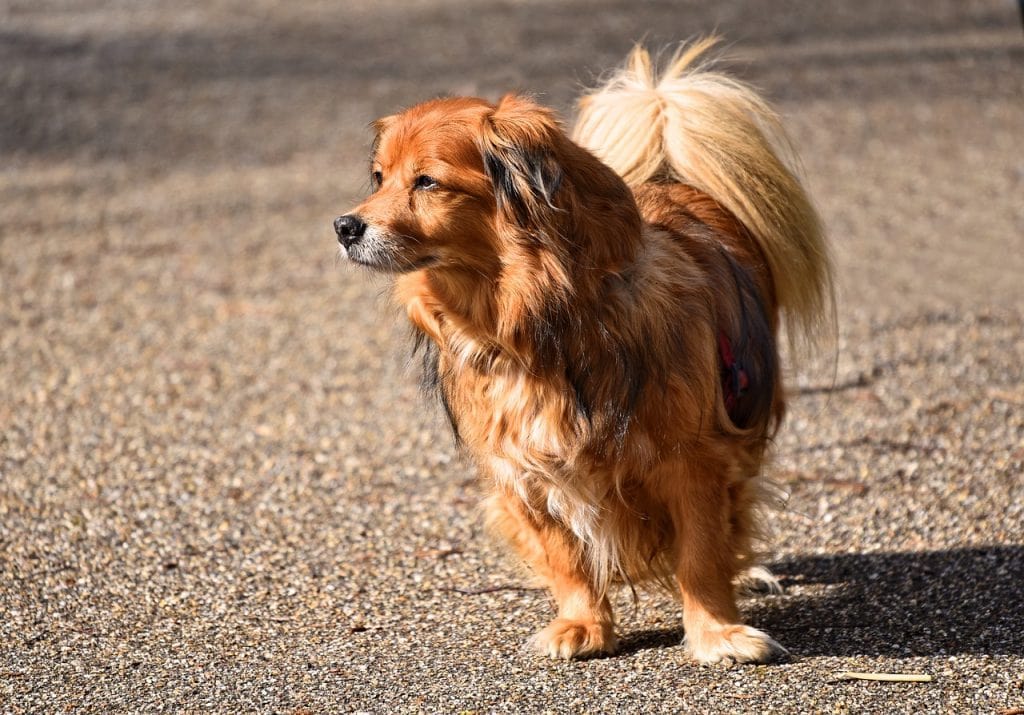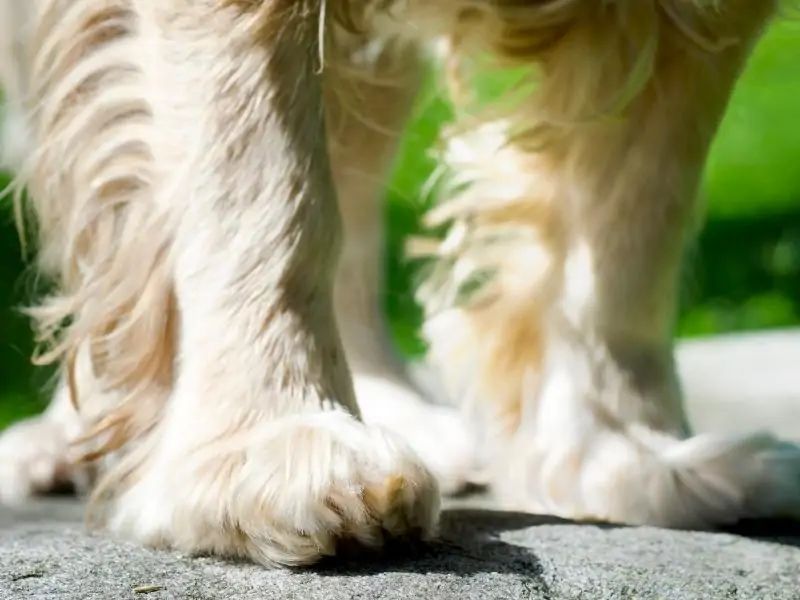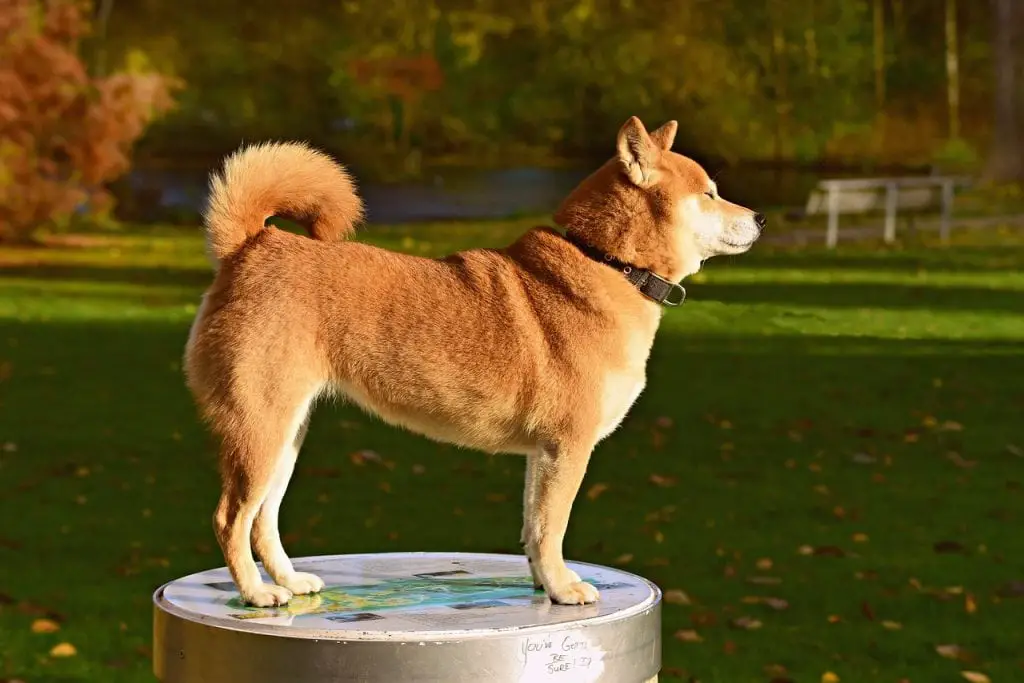As you watch your new dog play in an unfamiliar environment, you notice that his legs seem to turn outward somewhat.
And, as your dog jumps on the hardwood floors, the outward pointing feet seem even more obvious.
An issue that has boggled the minds of many dog owners is the phenomenon of a dogs’ legs turning outward.
Why do my dog’s feet turn outward when he is standing?
A dog’s feet turn outward for many reasons, including; genetic fault, issues with weight, length of nails or an injury like elbow dysplasia. Certain breeds are more prone to their feet turning out than others.
While it can be a cause for concern, most dogs can live healthy and happy lives even with turned out feet.
Although dogs are seen as hearty and healthy creatures, small issues can cause big problems for them.
Therefore, it is vital that pet owners should pick up any issues as soon as possible.
What Do Healthy Dogs Legs and Feet Look Like?

When you look at the average dog, their feet should face forward.
It is common knowledge that a dog’s resting standing posture is an excellent way to check a dog’s health.
Ideally, a dog should stand with its legs straight and feet facing forward.
The reason for this is that dogs usually have a lower metabolic rate and their way of conserving energy is by stacking their weight on a vertical column.
Therefore, dogs that face forward are viewed as healthier.
Good posture is something that is especially important in dog shows as it shows neurological strength (source).
Some dogs do “toe-out” as puppies and generally, this is not significant.
As they grow older and develop, their chests will “drop” and fill in, which automatically the corrects the East-West toe out.
Dogs should then stand with feet facing outward (source).
If this is not the case, there may be another explanation for feet facing outward.
Causes of Feet Turning Outward
It is important to know what the root cause of any bad posture is.
This can help in correcting it, if possible, and knowing the potential consequences for the dogs’ health.
Genetic issues
A rear pastern is something that is responsible for a dog’s gait.
The rear pastern is the section of the dog’s legs, starting from the ankle and continuing to the ball-shaped joint of their back legs (source).
If a dog has a weak or high pastern, it might affect their ability to remain stable while walking.
Some dogs compensate for this weakness by walking with their rear feet facing outward.
Breeds prone to outward turning feet
Small and long dogs like Dachshunds, Basset Hounds and Bulldogs are more likely to have issues with feet facing outward.
This may be due to their small sizes and a lower center of gravity, which makes it more likely that they may have bad posture as a way of stabilizing themselves.
Treatment
Genetic issues are difficult to treat as you cannot change the length of your dog’s bones.
The best way to ensure your dog stays healthy is to lessen the amount of strain that is placed on their joints.
This can be done by avoiding overly strenuous exercises and jumping too often.
Canine Elbow Dysplasia

Canine Elbow Dysplasia (CED) is a condition that involves abnormalities in the elbow joint.
This condition can cause a range of issues from feet turning out to lameness in dogs if left untreated.
An unnatural gait and feet turning outward are one of the possible signs of elbow dysplasia but it may show through other symptoms as well.
This condition occurs when the three bones that make up the elbow joint do not fit together properly due to abnormalities in bone structure.
There are several reasons that may cause Canine Elbow Dysplasia to take place which include disease and injury (source).
This issue seems to affect bigger dogs.
Treatment
If you suspect that your dog is suffering from CED, it is best to take them to a vet.
Treatment generally involves surgery unless the issue has been caught early enough to fix through non-medical methods.
Carpal Valgas
The carpus is the equivalent of your dog’s wrist.
The development deformity that takes place on the carpus is called Carpal Valgus.
This condition generally affects puppies but has been known to continue until 7 months into the dog’s life (source).
The condition affects the front legs and causes a turning out of the feet.
There is not a lot of information about what causes this condition, but theories include an imbalance in growth between the bones and tendons of the front legs.
Treatment
If the theory above is to be accepted, it is suggested that puppies should not be given less food than recommended as a way of slowing their growth and reducing the effects of the imbalance.
However, the ideal course of action would be to take the puppy to the vet and allow them to be examined personally.
Medial Patellar Luxation
Medial Patellar Luxation (MPL) is a common orthopaedic disease that affects smaller dogs such as Yorkshire Terriers, Papillons, Toy Poodles and Pomeranians (source).
This disease has an effect on the back legs of the dog and causes turning out of the hind feet.
To learn more about caring for Yorkies, you can read Silverback Yorkies: What You Need to Know.
While this disease presents differently as the condition worsens, the turning out of feet could be seen as a symptom.
It is a method that the dog adopts to reduce the movement of the knee (patella) as MPL usually presents as the knee joint removes itself from the socket, which causes a lot of discomfort for the affected dog (source).
Treatment
Generally, treatment is not surgical unless the MPL has progressed significantly.
A veterinary surgeon would be best able to diagnose and treat the condition.
Commonly used methods include increasing the groove that the knee joint rests in and reconstructing soft tissue that surrounds the kneecap.
Weight
Some dogs, especially toy dogs like Yorkies or small hounds like Dachshunds, are more prone to injury through weight gain.
As the body of the dog is quite small, they are able to gain more weight through unhealthy eating habits like too many snacks or table scraps.
The weight adds strain to their spines which is harmful by itself, but it also forces the dogs to change their posture to maintain balance (source).
The dog may splay its legs by turning its feet outwards.
On a related note, if a dog does not get all the required nutrients from their food, they may also develop weaker bones which can exacerbate the issue.
Treatment
It is important that dogs are kept healthy through a balanced diet and exercise.
They should not be given too many snacks or high protein foods.
If you notice that your little dog is gaining weight, then more exercise should be incorporated into their daily routine and food portions may be reduced slowly.
As always you should consult your veterinarian for advice for your specific situation.
Length of nails
As in humans, dog nails are also something that needs to be cared for.
Long nails for dogs can lead to many problems that could lead to injury or even long term deformities if they are not treated (source).
Dogs with long nails often have issues placing their paws flat on the ground.
This can lead to bad posture as the dog will change its position to naturally accommodate the lack of grip.
Some dogs will turn their feet outward when standing or walking to place more pressure on the pad of the foot and not on the front where the nail is.
For quick and easy steps about trimming dog nails, see video below:
Treatment
Dogs’ nails should be kept short and constantly trimmed.
It is preferable to use a grinding tool to do so as it allows more controlled trimming, compared to clippers.
If an owner does not feel like they are up to the task, it is advisable to allow a groomer to trim the dog’s nails.
Possible Long-Term Effects of a Dogs Feet Turning Outward

If a puppy is affected by turned out feet or “toeing out”, most of them grow out of it as they mature.
In the case where this does not happen, the onus is on the owners to ensure that the dog stays healthy through regular, non-strenuous exercise and avoidance of areas that may be harmful to the dog, such as stairs.
Once you become concerned with your dog’s development you should take them to the veterinarian to see if there is something to your concern.
In the case of a genetic disease, you may consider not breeding your dog.
However, for the dog that has already developed the condition, they require love and care to maintain their health and happiness.
Just as our animals love us despite our imperfections, we owe them the same treatment.
Related Content: What Should You Do if Your Puppy Falls off the Couch? Are dogs even that flexible for falling?
Final Thoughts
Clearly there are a lot of variables that can cause the turning out of dogs’ front or back legs.
It cannot be said that there is a “safe” dog that would not be prone to these as various issues affect a range of dog breeds and types, from small to large breeds.
As the owner, you can do your best for your dog by bringing them to the veterinarian once you notice something so you can come up with a plan of action together.


0 Comments